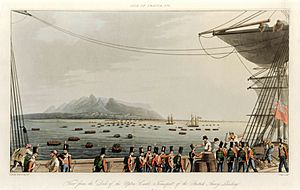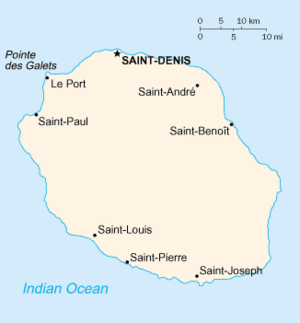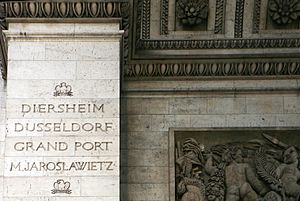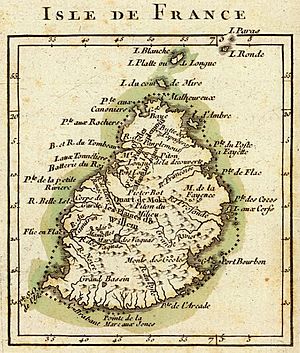Mauritius campaign of 1809–1811 facts for kids
Quick facts for kids Mauritius campaign |
|||||||||
|---|---|---|---|---|---|---|---|---|---|
| Part of the Napoleonic Wars | |||||||||
 View from HMS Upton Castle of the British conquest of Île de France in 1810 |
|||||||||
|
|||||||||
| Belligerents | |||||||||
| Commanders and leaders | |||||||||
| Josias Rowley Henry Keating Albemarle Bertie and others |
Charles Decaen Jacques Hamelin and others |
||||||||
The Mauritius campaign of 1809–1811 was a series of land and sea attacks. These battles decided who would control the French islands of Isle de France (now Mauritius) and Île Bonaparte (now Réunion). This happened during the Napoleonic Wars.
The campaign lasted from 1809 to 1811. Both the Royal Navy (British) and the French Navy sent many fast warships called frigates. Their goal was to either stop or protect trade ships from British India. The Royal Navy was usually very strong at sea. However, the French Navy had a big advantage in late 1810. This was after the British lost badly at the Battle of Grand Port. This was the Royal Navy's biggest defeat in the whole war.
After their victory, the British gave Isle de France its original Dutch name, Mauritius. In 1814, Île Bonaparte was given back to France. It was later renamed La Réunion.
The Royal Navy had planned to take Isle de France for a while. But they had to act sooner than expected. This was because France sent a strong group of frigates in late 1808. This French force, led by Commodore Jacques Hamelin, captured many large trading ships from India. They also messed up trade routes in the Indian Ocean.
To stop this, Admiral Albemarle Bertie ordered Commodore Josias Rowley to surround the French islands. This would stop them from being used as raiding bases. For the next two years, the British attacked French ports. The French, in turn, attacked British trade convoys. The British slowly weakened the French by taking over their bases. But they faced a major defeat at Grand Port in August 1810. This forced them to play defense for a while.
Hamelin was finally defeated when he was captured on his ship, the Vénus, by Rowley. Soon after, more British forces arrived. They were led by Bertie and quickly took Isle de France. Hamelin could not get help from France. Most attempts to break through the British blockade of French ports failed. Only one frigate reached the Indian Ocean before Isle de France surrendered. The last French attempt arrived in May 1811. But they found the island was already British. On their way back, the French ships were attacked and defeated near Madagascar. This left the British in full control of the Indian Ocean.
Contents
Why the Campaign Started
The Indian Ocean was a very important part of the British Empire's trade routes. Merchant ships from China, Arabia, and East Africa regularly crossed it. At its center was India. From India, large trading ships called East Indiamen carried goods worth millions of pounds to Britain every year. This trade was vital for Britain's money. So, protecting these trade routes was a top priority for the Royal Navy.
When the Napoleonic Wars began in 1803, these routes were in danger. Dutch ships from Cape Town and the Dutch East Indies were a threat. French ships from Isle de France and Île Bonaparte were also a danger. By 1808, most Dutch colonies were under British control. But the French islands were much harder to attack. They had strong forts and many French soldiers. They were also far from the nearest British port.
At first, French private ships, called privateers, attacked British ships. These were private ships allowed to attack enemy ships. Sometimes, French navy ships also joined in. But they were not strong enough to cause big problems for British trade. In late 1808, France sent four large, powerful frigates to Governor Charles Decaen on Isle de France. These ships were the Vénus, Manche, Caroline, and Bellone. Their job was to attack British trade in the Indian Ocean. These frigates had many sailors and safe harbors on Isle de France.
To fight back, Vice-Admiral Albemarle Bertie put together a small British force. It was led by Commodore Josias Rowley. Their orders were to surround Isle de France and Île Bonaparte. They also had to capture or destroy any French ships there. Rowley's force included the large warship HMS Raisonnable and several frigates. Both the British and French forces arrived in the Indian Ocean in early 1809.
Key Battles and Events
Early Attacks
Hamelin's French ships quickly caused problems. The Caroline attacked British trading ships in May 1809. She captured two ships, the Streatham and Europe. She then returned to Île Bonaparte with her prizes (captured ships). Hamelin also sailed in the Bay of Bengal. His ship, Vénus, captured a British warship called Orient in July.
Rowley's British force was also busy. HMS Nereide captured several small ships. Another British ship, HMS Otter, attacked a French anchorage in August. Captain Nesbit Willoughby of the Otter captured a coastal ship. He also recaptured a British brig called Aigle. Rowley himself chased the French ship Bellone but could not catch her. The most important British action was taking the island of Rodrigues. This small island was close to Isle de France. It became a good base for the British to block the French islands. It was also a place to prepare for a future invasion.

Rowley's first big attack happened when the Caroline returned to Île Bonaparte. She was hiding in Saint-Paul harbor. This made her an easy target. On September 21, over 600 British soldiers, sailors, and marines landed on Île Bonaparte. They marched around the town's forts and attacked them from behind. They captured the gun batteries overlooking the port. This allowed Rowley to bring his ships into the harbor. The French naval officers abandoned their ships. The British then captured the Caroline and the two trading ships she had taken. The British also took government supplies and destroyed buildings. Rowley's force left Saint-Paul on September 28.
While Rowley was at Saint-Paul, Hamelin's ships were attacking in the Bay of Bengal. On October 10, Hamelin attacked a British base in Sumatra and burned it. On November 2, the British brig HMS Victor was captured by the Bellone. Two weeks later, Hamelin captured three more large trading ships. On November 22, the Bellone defeated a Portuguese frigate. Hamelin's ships were then hit by a storm. The Vénus was badly damaged. By December 31, all ships returned to Isle de France. One captured ship, the Windham, was recaptured by a British frigate.
Taking Île Bonaparte
The French Navy felt good about 1809. They sent one more frigate, the Astrée, to Hamelin in early 1810. This was the only ship that got past the British blockade. Hamelin quickly sent ships out again. Captain Guy-Victor Duperré in Bellone and Captain Pierre Bouvet in the captured Minerve went to raid in the Bay of Bengal. Duperré captured two more trading ships, Windham (again!) and Ceylon, in July.
Soon after Duperré left, a British squadron arrived to restart the blockade. Rowley sent Willoughby in Nereide to attack French coastal areas. On April 30, Willoughby attacked a protected harbor. His men landed at night under heavy fire. They captured two French gun batteries. Willoughby was badly wounded when his musket exploded. He had to recover for several months.
During this time, Rowley's force got smaller. But he began to plan the invasion of Île Bonaparte. This island was smaller and not as well defended. On June 24, Rowley gathered over 3,000 soldiers. On July 7, Rowley's force landed on Île Bonaparte. They quickly moved against the weak French defenses. The island's governor surrendered the next day. During this time, Matthew Flinders, a British explorer held prisoner by the French, was freed. He gave Rowley important information about the defenses on Isle de France.
The Battle of Grand Port
Even before Île Bonaparte surrendered, Rowley looked to Isle de France. He decided the best way to stop Hamelin's ships was to block the island's main ports. This meant taking the small islands that guarded the harbor entrances. Captain Samuel Pym in Sirius and Willoughby in Nereide were chosen for this. They were to start by taking Île de la Passe at the entrance to Grand Port.
Willoughby stormed and captured Île de la Passe on August 13. This blocked the entrance to Grand Port. Pym, with other British ships, blocked Port Napoleon. On August 20, Duperré's French squadron was seen approaching Grand Port. Willoughby tried to trick them into sailing into the channel. He flew French flags. But as the French ships passed, Willoughby's trap went off. A French flag on the fort accidentally caught fire and caused an explosion. In the confusion, all but one of Duperré's ships got into the harbor safely.
Willoughby asked Pym for help. Pym brought his ships to attack Grand Port on August 23. But Pym had not checked the channel properly. Duperré had also removed the warning buoys. So, Pym's ships sailed blindly into dangerous reefs. Sirius and Magicienne got stuck. Iphigenia struggled to get close. Only Nereide reached the French ships. Willoughby's attack was so strong that the French ships were driven ashore. Only Bellone could still fight. A lucky shot from Bellone cut Nereide's anchor cable. The British ship swung around, showing her back to the French. The French ships fired heavily. Nereide was badly damaged, with over 220 crew killed or wounded.
Nereide surrendered on August 24. Over the next three days, Magicienne and Sirius were burned to stop the French from taking them. On August 28, Iphigenia, full of survivors, met Hamelin's main French squadron. Outnumbered, the British captain had to surrender. This was the worst British naval defeat of the entire war. Rowley arrived the next day but could not help. He sent urgent messages for more ships.
On September 11, the British frigate HMS Africaine arrived. Rowley recaptured her the next day. The danger from Hamelin's ships was clear. On September 18, the British ship HMS Ceylon was captured by Hamelin's Vénus. Again, Rowley recaptured the British frigate. This time, the Vénus was so damaged that she could not escape. She was captured with Hamelin on board.
Taking Isle de France
In late 1810, many British navy and army forces arrived. They came from India and the Cape of Good Hope. The British wanted to end the threat from the French ships on Isle de France. They needed to do this before the hurricane season made travel too dangerous. The French ships were already badly damaged. They could not be repaired because there were no supplies on the island. Also, food was running low, and morale was low after Hamelin's defeat.
By late November 1810, the invasion force was ready. Vice-Admiral Albemarle Bertie took command. He decided to land at Grand Baie, north of the island's capital. The landing was led by Captain Philip Beaver. The first troops ashore were a special group under Keating. They would advance on Port Napoleon. The main force of nearly 7,000 soldiers would follow. This force was much larger than the French defenders, who had about 1,300 soldiers. The British wanted a quick victory.
The invasion fleet of 70 ships sailed on November 22. They reached Grand Baie on November 29. The French did not try to stop the landing. Keating quickly moved towards the capital. French militia units retreated. On November 30, Keating's troops were fighting French soldiers near the capital. The next morning, the French commander tried to stop them. But Keating's larger force defeated the French. Port Napoleon fell. A ceasefire was agreed on December 2. The next day, Decaen surrendered. He and his men were sent back to France with their weapons.
What Happened Next
The fall of Isle de France ended the British campaign. Six French frigates and over 200 cannons were captured. The island itself was returned to its original Dutch name, Mauritius. It has been called Mauritius ever since. The island stayed under British control until it became independent in 1968.
The British forces in the area were reduced. Ships were sent to clear out any remaining French bases on Madagascar and in the Seychelles. News traveled slowly back then. So, the French government did not know about the island's fall until February 1811. They sent more ships and supplies to help Hamelin's squadron. This French squadron arrived on May 6. They almost fought a British force but escaped. They stopped at Tamatave on Madagascar. There, a British force caught them on May 20 and defeated them. This battle, the Battle of Tamatave, happened in very light winds. The ships were often stuck without wind.
Two French frigates were lost at Tamatave. This meant the French Navy lost ten frigates during the campaign. This defeat ended the campaign. It also ended France's hopes of stopping British trade with India. The only remaining safe French harbors were a few Dutch colonies on Java. These became the next target for the Royal Navy.
The Mauritius campaign also affected how Britain planned its future in the Indian Ocean. They kept Mauritius as a colony. This gave them important bases along their trade routes. British trade ships were safer. The Royal Navy also had the support it needed to operate all over the world.

The campaign became famous in Britain and France. The Battle of Grand Port is the only naval battle shown on the Arc de Triomphe in Paris. In Britain, Rowley and Bertie were made baronets (a special title) for their service.
In Books
The 1977 novel The Mauritius Command by Patrick O'Brian tells a story very similar to the British campaign. The main character, Jack Aubrey, takes the place of Rowley.





